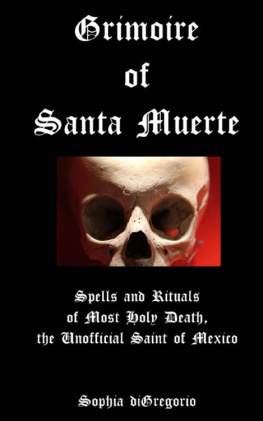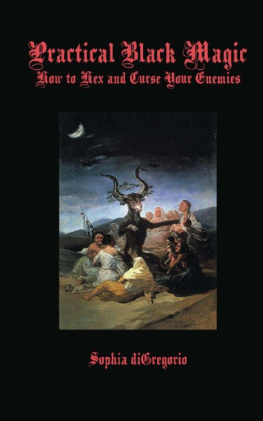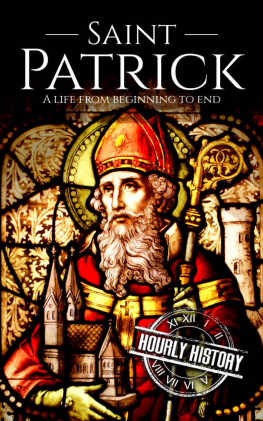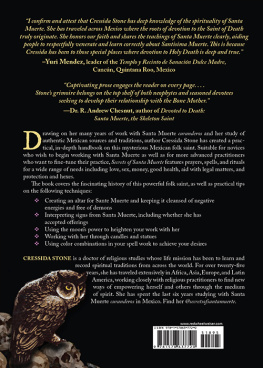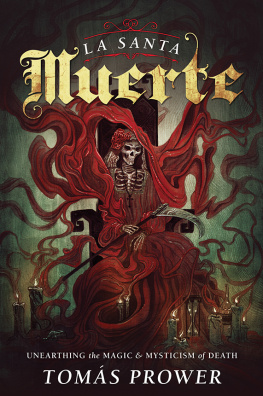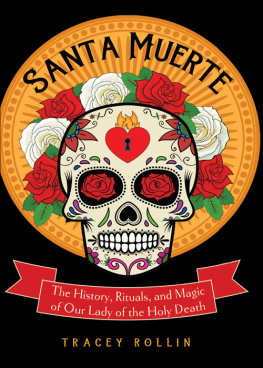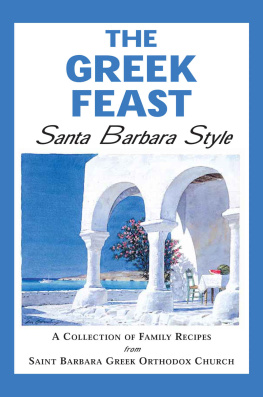Grimoire of Santa Muerte:
Spells and Rituals of Most Holy Death, the Unofficial Saint of Mexico
by Sophia diGregorio
Copyright 2013 by Sophia diGregorio
Winter Tempest Books
All rights reserved.
Smashwords Edition
Smashwords Edition, License Statement
This ebook is licensed for your personal enjoyment only. This ebook may not be re-sold or given away to other people. If you would like to share this book with another person, please purchase an additional copy for each reader. If youre reading this book and did not purchase it, or it was not purchased for your use only, then please return to Smashwords.com and purchase your own copy.
This document contains material protected under copyright laws.
This document contains material protected under copyright laws.
Any unauthorized storage, reprint, transmission or resale of this material without the express permission of the author is strictly prohibited.
Author's Note
I made my personal discovery of Mexican witchcraft in the 1980s in El Paso, Texas. As an occultist, my attraction to it is a natural one since I come from a long line of devoted Catholics and Spanish and English are my first two languages. But, it was not until 2007, while browsing in a tienda in Houston, Texas, that I first laid eyes on Santa Muerte. It was love at first sight and she has had a place in my heart and my home ever since.
I wrote this book, which is the first of a series on the subject of Santa Muerte, as an introduction to her devotion, especially for English-only speaking, non-Catholics, who are the majority in English-speaking countries.
Like all grimoires, it is nothing more than a handbook and a guide, whereas the actual practice of connecting with Santa Muerte is a highly personal one, which is slightly unique to each devotee. It is my hope that this book sets you on your own richly rewarding journey with her.
Sophia diGregorio Contents
Chapter 1
Who is Santa Muerte?
Santa Muerte is a spirit, called a folk saint, associated with a number of ancient and modern legends in Mexico. To those devoted to her, she is their friend, a spiritual mother and the source of love and protection from whom all the necessities of life flow. She is an advocate, a healer and the performer of miracles.
She is the patron saint of those who have confronted death and lived and those who must face deadly situations every day.
She is the patron saint of those who have confronted death and lived and those who must face deadly situations every day.
To her devotees, she promises protection from sudden death and she acts as a psychopomp, conducting the spirits of the dead safely to their destination in the Underworld. She is, also, a spirit of second chances who avenges her devotees and punishes evil-doers.
Those familiar with the occult know there are forces all around us, which may not always be working in our favor. Santa Muerte protects her devotees from all forms of malefic witchcraft. She is a godmother who guides those under her care and arranges things in their favor in much the same way as a benevolent and powerful living benefactor might.
She, also, provides protection from criminals and corrupt law enforcement agents.
She, also, provides protection from criminals and corrupt law enforcement agents.
Some Mexican police officers place images of Santa Muerte on their uniforms and on their weapons, signifying their devotion and the consecration of these items to her for protection.
Devotees establish a long-term relationship with Santa Muerte, which is not a matter of faith, but of practicality and functionality. Many people, who never received answers to their prayers to Jesus, God, Mary or other saints, find that Santa Muerte fulfills their requests very reliably and quickly.
Where the church and state have failed to meet the needs of the people in Mexico, Santa Muerte has succeeded. For example, the Santa Muerte shrine in the Tepito district of Mexico City takes on the role the Catholic Church used to hold by providing a sanctuary to devotees and shielding them from corrupt government officials.
Miracles of Santa Muerte
"En dios creo y en ti confio."
"In God I believe, in you I trust ."
Many, if not most, devotees of Santa Muerte in Mexico are Catholics who believe in God.
Miracles of Santa Muerte
"En dios creo y en ti confio."
"In God I believe, in you I trust ."
Many, if not most, devotees of Santa Muerte in Mexico are Catholics who believe in God.
Yet, it is not to this god that they turn in times of trouble, but to Santa Muerte who delivers results swiftly, without judgment and never fails, no matter what the problem is.
Santa Muerte performs a variety of miracles, including the following:
The sick are healed Children are born healthy The unborn are protected Families are protected Homes are protected Lives are saved Those near death are given a second chance Devotees are protected from accidents The wronged are avenged Lost lovers are returned Relationships are improved Addictions are broken Justice is served Prisoners are freed and given a second chance Enemies are thwarted Riches are obtained and protected Peace is maintained Dangerous enemies are struck down Obstacles are overcome Worries are laid to rest Evil is dispelled Devotees are protected from the Evil Eye and malefic witchcraft
The Origins of Santa Muerte
The modern Santa Muerte is a synthesis of southwestern European pagan deities and pagan deities of the Mexican Indians. The pagan view of death both in Europe and among the Indians is very different from the Christian concept.
The Christian view of death involves judgment, punishment, the fires of Hell and separation from the world of the living. In contrast, the pagan concept of death is not only more tranquil, but the dead are seen as a source of assistance, guidance and comfort.
Spirit communication, including communication with the dead, is a very normal part of life for many Mexicans because of their understanding that the spirits of the dead are all around us.
Spirit communication, including communication with the dead, is a very normal part of life for many Mexicans because of their understanding that the spirits of the dead are all around us.
This fact of life has its roots in some aspects of Catholicism, which involve communication with the spirits of saints and seeking their help in a variety of situations.
Necromancy, in which the bones and other relics of the dead impart their influence upon spirit communication, is inherent to both Catholicism in Western Europe and Mexico. It, also, has its roots in the paganism of Western Europe and the beliefs and practices of the Mexican Indians, which stretch back long before the arrival of the Europeans.
The Spaniards' conception of death was one of fear, judgment, suffering and punishment in the afterlife. By the 10th century in Spain, they began celebrating la Conmemoracin de los Fieles Difuntos , "The Commemoration of the Faithful Dead," however, the purpose of their celebration was to remind the living that life is fragile and to illustrate the dangers of not remaining faithful to the Christian god. This Spanish celebration was later synthesized with indigenous pagan beliefs and popularized in Mexico as la Dia de los Muerto s, "The Day of the Dead," which is celebrated on November 2nd.
This is the day upon which the spirits of the dead return, so food, flowers and mementos of the deceased are placed on an altar in their honor.
The Aztec capital city of Tenochtitlan, now known as Mexico City, was established in 1375. The Aztec goddess of death Mictecacihuatl, whose brother is Mictlantecuhtli, is represented either as a skull or a full skeleton. Although, she is only one of many pre-Christian Mexican death goddesses, Mictecacihuatl is the one researchers most often cite as the Indian origins of Santa Muerte.
Next page
